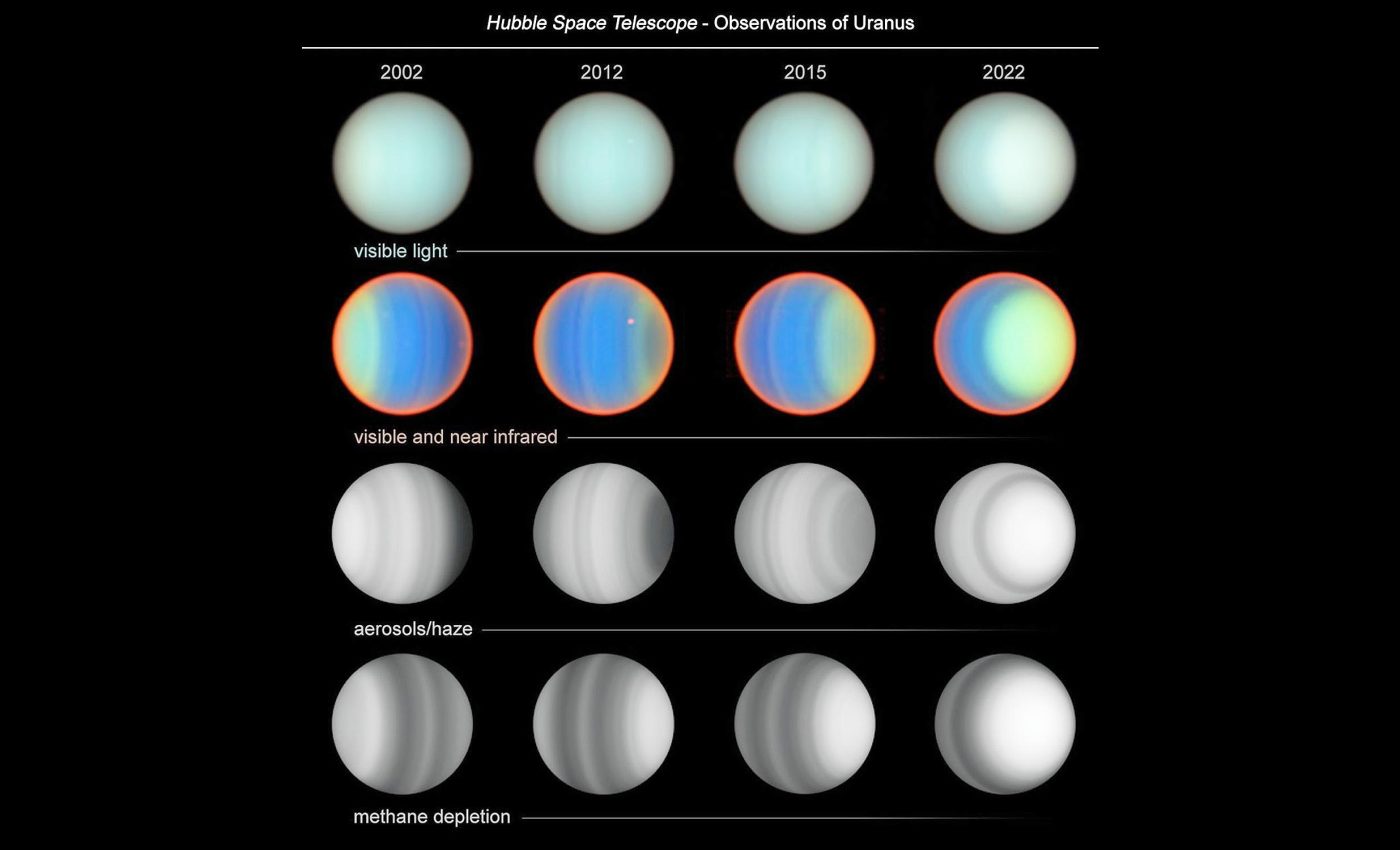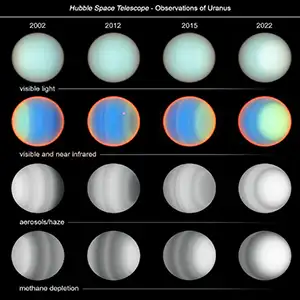
Hubble finds Uranus full of surprises after 20 years of observations
Astronomers have been watching Uranus for decades and, until recently, it seemed like a fairly calm, blue-green planet. But new findings, based on two decades of observations from NASA’s Hubble Space Telescope, paint a different picture.
Uranus is full of surprises, with shifting patterns of haze, uneven distributions of methane, and giant seasonal changes that take place on a timescale of decades.
These changes have big implications not only for our understanding of this strange ice giant, but also for how we might interpret data from similar exoplanets in distant star systems.
Hubble finds complexity on Uranus
When Voyager 2 passed by Uranus in 1986, it revealed what looked like a smooth billiard ball with a teal hue. That impression stuck for a long time.
But starting in 2002, a team of researchers led by Erich Karkoschka from the University of Arizona, and Larry Sromovsky and Pat Fry from the University of Wisconsin used Hubble’s Space Telescope Imaging Spectrograph (STIS) to take a closer look.
Over the following twenty years, they discovered that Uranus isn’t static at all. Instead, sunlight shifts the planet’s appearance as it tilts throughout its 84-year orbit around the Sun.
Uranus is mainly composed of hydrogen, helium, and methane, with the methane responsible for its cyan color because it reflects blue-green light and absorbs red.
Yet the Hubble data show that methane is not spread evenly around the planet. It’s severely depleted at both poles but remains more abundant at mid and lower latitudes. On top of that, researchers see big swings in aerosol hazes over time, especially near the poles.
A planet tipped on its side
The dramatic tilt of Uranus – which essentially rolls around the Sun like a barrel – means its poles each get about 42 years of continuous sunlight followed by 42 years of darkness.
In the last two decades, the north pole has gradually come into more direct sunlight.
Hubble’s observations show that this brightening sunlight appears to correlate with thicker haze, making the north pole shine more vividly. Meanwhile, the south pole is losing light and has been dimming.
This is why the planet doesn’t look quite the same from year to year. An area that was relatively dark a decade ago could become much brighter as it moves into the spotlight.
Conversely, the region on the far side of the planet recedes into darkness, causing its cloud features to fade from view.
Uranus, Hubble, and methane
Scientists expected that methane, the main ingredient behind Uranus’s distinctive color, would be key to understanding the planet’s atmosphere.
But what they found is that methane distribution varies more dramatically than anticipated, hinting at complex circulation patterns.
Their data point toward upwelling in some areas – where methane-rich gas rises to the top – and strong downwelling at the poles, which flushes methane out of the visible layers of the atmosphere.

This interplay also seems tied to changes in cloud cover and haze formation. In false-color images from Hubble, researchers can pick out details that are invisible to the naked eye.
They can see exactly where methane is absent, where it’s abundant, and how these conditions tie to different latitudes or altitudes.
Seasons that last decades
For Earth, seasons last a few months. For Uranus, one season can stretch over two decades. That’s what makes Hubble’s long-term observations so valuable: short missions like Voyager’s quick flyby provide just a snapshot.
Now, by capturing repeated views over many years, astronomers can piece together how the planet’s weather and seasons evolve.
The data from 2002 through 2022 capture what amounts to “late spring” in Uranus’s northern hemisphere, heading into northern summer solstice in 2030.
Over that span, the planet’s north pole has gone from modestly bright to intensely reflective, likely due to changes in the thickness or composition of haze. On the opposite side, the south polar region has moved deeper into shadow.
Looking beyond Uranus
Uranus is not just an oddity at the edge of our solar system. Ice giants like Uranus and Neptune are common throughout the galaxy, and many exoplanets we discover may be similar.
Learning how an ice giant’s atmosphere responds to sunlight, chemical processes, and extreme axial tilt can guide us in interpreting data from faraway star systems.
Some NASA scientists and engineers are already discussing sending a dedicated orbiter to Uranus in the coming decades.
If built, that spacecraft could peel back even more layers of mystery: sampling the planet’s magnetic field, studying its faint ring system, and measuring wind speeds from within.
But in the meantime, Hubble’s slow, steady watch continues to reveal new details each time Uranus comes into view.
New chapter in ice giant science
For now, researchers are sifting through this wealth of Hubble data to refine their theories about Uranus’s climate.
The findings confirm that even at great distances from the Sun, solar radiation can dramatically impact weather and haze formation.
They also highlight how crucial long-duration missions like Hubble are for understanding planetary atmospheres. A single pass from a space probe could never have captured the unfolding story of Uranian seasons quite like this.
In short, the once “boring” Uranus now appears to be a place of shifting hazes, peculiar circulation, and slow but strong seasonal makeovers.
Observing this unlikely show at the solar system’s edge, astronomers are constantly reminded that no planet can be written off as uninteresting – especially not one that literally travels on its side and is full of hidden surprises.
Image provided by NASA.
—–
Like what you read? Subscribe to our newsletter for engaging articles, exclusive content, and the latest updates.
Check us out on EarthSnap, a free app brought to you by Eric Ralls and Earth.com.
—–













